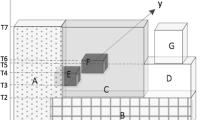Abstract
Temporal and spatial reasoning are two important parts of Artificial Intelligence and they have important applications in the fields of GIS (geographic information system), Spatiotemporal Database, CAD/CAM etc. The development of temporal reasoning and spatial reasoning includes three aspects: Ontology, representation models and reasoning methods. This paper checks the correspondence between spatiotemporal relations and the 3D topological relations and presents a relation analysis model for indeterminate evolving 2D regions. It extends the 2D Egg/Yolk model into the third dimension that can describe the approximate topological relations for indeterminate evolving regions. The result is a collection of relation clusters that have different spatiotemporal natures.
Preview
Unable to display preview. Download preview PDF.
Similar content being viewed by others
References
Schneider, M.: Finite resolution crisp and fuzzy spatial objects. In: Proceedings of the 9th International Symposium on Spatial Data Handling, pp. 3–17. International Geographical Union, Beijing (2000)
Winter, S.: Uncertainty of topological relations in GIS. In: Proceedings of ISPRS Commission III Symposium: Spatial Information from Digital Photogrammetry and Computer Vision, Bellingham, pp. 924–930 (1994)
Clementini, E., Felice, D.: Approximate topological relations. International Journal of Approximate Reasoning 16(2), 173–204 (1997)
Cohn, A.G., Gotts, N.M.: The ‘Egg-Yolk’ representation of regions with indeterminate boundaries. In: Burrough, P.A., Frank, A.U. (eds.) Geographic Objects with Indeterminate Boundaries, pp. 171–187. Taylor & Francis, London (1996)
Andrew, U.F.: Qualitative spatial reasoning about cardinal directions. In: Proc. of the 7th Austrian Conf. on Artificial Intelligence, Baltimore, pp. 157–167 (1991)
Christian, F.: Using orientation information for qualitative spatial reasoning. In: Proc. of the Int’l. Conf. on GIS, pp. 162–178. Springer, Berlin (1992)
Roop, G., Egenhofer, M.: Similarity of Cardinal Directions. In: Advances in Spatial and Temporal Databases, pp. 36–55. Springer, Redondo Beach (2001)
Wolter, F., Zakharyaschev, M.: Qualitative spatio-temporal representation and reasoning: A computational perspective. In: Exploring Artificial Intelligence in the New Millenium, San Francisco, pp. 175–216 (2002)
Bennett, B., Cohn, G., Wolter, F., Zakharyaschev, M.: Multi-Dimensional modal logic as a framework for spatio-temporal reasoning. Applied Intelligence 3(4), 239–251 (2002)
Asher, N., Vieu, L.: Towards a geometry of common sense: A semantics and a complete axiomatisation of mereotopology. In: Proc. of the 14th Int’l Joint Conf. on Artificial Intelligence, Montréal, pp. 846–852 (1995)
Muller: Topological spatio-temporal reasoning and representation. Computational Intelligence 18(3), 420–450 (2002)
Medak, D.: Lifestyles—A paradigm for the description of spatiotemporal databases, Ph.D. Thesis. Technical University Vienna, Vienna (1999)
Viqueira, J.R.R.: Relational algebra for spatio-temporal data management. In: Proc. of the EDBT, Ph.D. Workshop. Konstanz, pp. 235–243 (2000)
Claramunt, C.: Extending Ladkin’s algebra on non-convex intervals towards an algebra on union-of regions. In: Proc. of the 8th ACM Symp. on GIS, Washington, pp. 9–14 (2000)
Ladkin, P.B.: The logic of time representation, Ph.D. Thesis. University of California at Berkeley, Berkekey (1987)
Muller: A qualitative theory of motion based on spatio-temporal primitives. In: Proc. of the 6th Int’l. Conf. on Knowledge Representation and Reasoning, Trento, pp. 131–143 (1998)
Erwig, M., Schneider, M.: Spatio-Temporal predicates. IEEE Trans. on Knowledge and Data Engineering 14(4), 881–901 (2002)
Tossebro, E., Nygard, M.: Uncertainty in Spatiotemporal Databases. In: Proc. 2nd Biennial Int. Conference on Advances in Information Systems, pp. 43–53 (2002)
Lei, B., Xiao-Lin, Q.: The Overview of Grey Spatiotemporal Data Types. In: 2nd Asian Workshop on Foundations of Software, Nanjing, pp. 53–57 (2003)
Wolfson, O.: Querying the Uncertain Position of Moving Objects. In: Etzion, O., Jajodia, S., Sripada, S. (eds.) Dagstuhl Seminar 1997. LNCS, vol. 1399, p. 310. Springer, Heidelberg (1998)
Author information
Authors and Affiliations
Editor information
Editors and Affiliations
Rights and permissions
Copyright information
© 2006 Springer-Verlag Berlin Heidelberg
About this paper
Cite this paper
Bao, L., Qin, XL., Zhang, J., Li, QY. (2006). Reasoning the Spatiotemporal Relations Between Time Evolving Indeterminate Regions. In: Yeung, D.S., Liu, ZQ., Wang, XZ., Yan, H. (eds) Advances in Machine Learning and Cybernetics. Lecture Notes in Computer Science(), vol 3930. Springer, Berlin, Heidelberg. https://doi.org/10.1007/11739685_47
Download citation
DOI: https://doi.org/10.1007/11739685_47
Publisher Name: Springer, Berlin, Heidelberg
Print ISBN: 978-3-540-33584-9
Online ISBN: 978-3-540-33585-6
eBook Packages: Computer ScienceComputer Science (R0)




